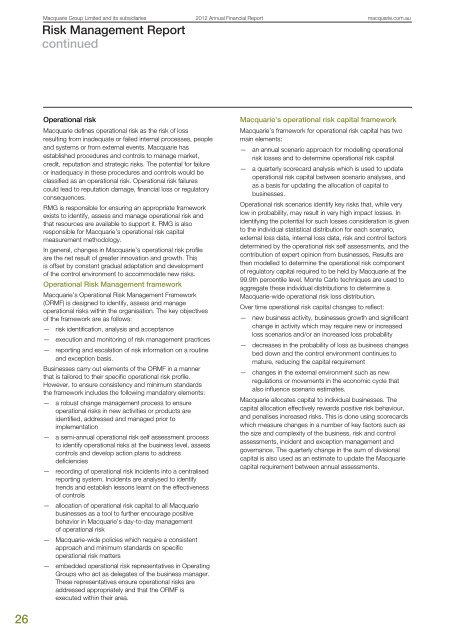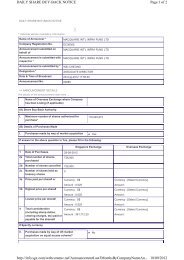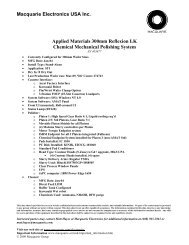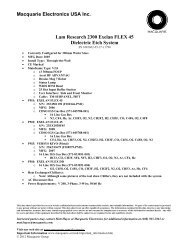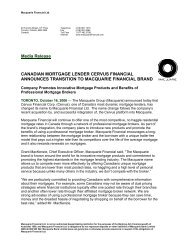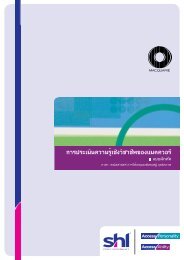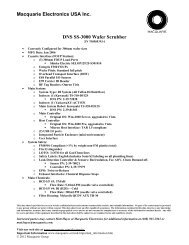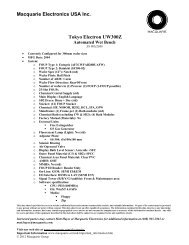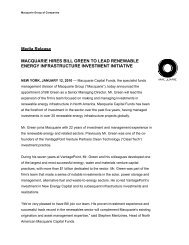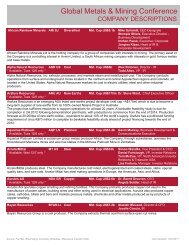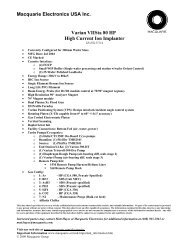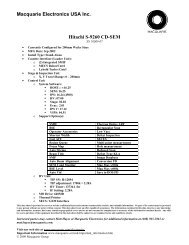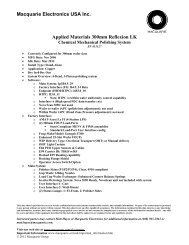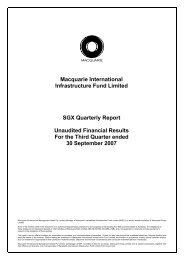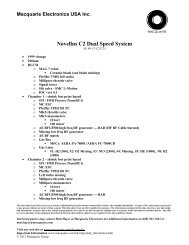Risk Management Policy and Systems - Macquarie
Risk Management Policy and Systems - Macquarie
Risk Management Policy and Systems - Macquarie
You also want an ePaper? Increase the reach of your titles
YUMPU automatically turns print PDFs into web optimized ePapers that Google loves.
26 26<br />
<strong>Macquarie</strong><br />
<strong>Macquarie</strong><br />
Group<br />
Group<br />
Limited<br />
Limited<br />
<strong>and</strong><br />
<strong>and</strong><br />
its<br />
its<br />
subsidiaries<br />
subsidiaries<br />
2012<br />
2012<br />
Annual<br />
Annual<br />
Financial<br />
Financial<br />
Report<br />
Report macquarie.com.au<br />
macquarie.com.au<br />
<strong>Risk</strong> <strong>Management</strong> Report<br />
continued<br />
Operational risk<br />
<strong>Macquarie</strong> defines operational risk as the risk of loss<br />
resulting from inadequate or failed internal processes, people<br />
<strong>and</strong> systems or from external events. <strong>Macquarie</strong> has<br />
established procedures <strong>and</strong> controls to manage market,<br />
credit, reputation <strong>and</strong> strategic risks. The potential for failure<br />
or inadequacy in these procedures <strong>and</strong> controls would be<br />
classified as an operational risk. Operational risk failures<br />
could lead to reputation damage, financial loss or regulatory<br />
consequences.<br />
RMG is responsible for ensuring an appropriate framework<br />
exists to identify, assess <strong>and</strong> manage operational risk <strong>and</strong><br />
that resources are available to support it. RMG is also<br />
responsible for <strong>Macquarie</strong>’s operational risk capital<br />
measurement methodology.<br />
In general, changes in <strong>Macquarie</strong>’s operational risk profile<br />
are the net result of greater innovation <strong>and</strong> growth. This<br />
is offset by constant gradual adaptation <strong>and</strong> development<br />
of the control environment to accommodate new risks.<br />
Operational <strong>Risk</strong> <strong>Management</strong> framework<br />
<strong>Macquarie</strong>’s Operational <strong>Risk</strong> <strong>Management</strong> Framework<br />
(ORMF) is designed to identify, assess <strong>and</strong> manage<br />
operational risks within the organisation. The key objectives<br />
of the framework are as follows:<br />
— risk identification, analysis <strong>and</strong> acceptance<br />
— execution <strong>and</strong> monitoring of risk management practices<br />
— reporting <strong>and</strong> escalation of risk information on a routine<br />
<strong>and</strong> exception basis.<br />
Businesses carry out elements of the ORMF in a manner<br />
that is tailored to their specific operational risk profile.<br />
However, to ensure consistency <strong>and</strong> minimum st<strong>and</strong>ards<br />
the framework includes the following m<strong>and</strong>atory elements:<br />
— a robust change management process to ensure<br />
operational risks in new activities or products are<br />
identified, addressed <strong>and</strong> managed prior to<br />
implementation<br />
— a semi-annual operational risk self assessment process<br />
to identify operational risks at the business level, assess<br />
controls <strong>and</strong> develop action plans to address<br />
deficiencies<br />
— recording of operational risk incidents into a centralised<br />
reporting system. Incidents are analysed to identify<br />
trends <strong>and</strong> establish lessons learnt on the effectiveness<br />
of controls<br />
— allocation of operational risk capital to all <strong>Macquarie</strong><br />
businesses as a tool to further encourage positive<br />
behavior in <strong>Macquarie</strong>’s day-to-day management<br />
of operational risk<br />
— <strong>Macquarie</strong>-wide policies which require a consistent<br />
approach <strong>and</strong> minimum st<strong>and</strong>ards on specific<br />
operational risk matters<br />
— embedded operational risk representatives in Operating<br />
Groups who act as delegates of the business manager.<br />
These representatives ensure operational risks are<br />
addressed appropriately <strong>and</strong> that the ORMF is<br />
executed within their area.<br />
<strong>Macquarie</strong>’s operational risk capital framework<br />
<strong>Macquarie</strong>’s framework for operational risk capital has two<br />
main elements:<br />
— an annual scenario approach for modelling operational<br />
risk losses <strong>and</strong> to determine operational risk capital<br />
— a quarterly scorecard analysis which is used to update<br />
operational risk capital between scenario analyses, <strong>and</strong><br />
as a basis for updating the allocation of capital to<br />
businesses.<br />
Operational risk scenarios identify key risks that, while very<br />
low in probability, may result in very high impact losses. In<br />
identifying the potential for such losses consideration is given<br />
to the individual statistical distribution for each scenario,<br />
external loss data, internal loss data, risk <strong>and</strong> control factors<br />
determined by the operational risk self assessments, <strong>and</strong> the<br />
contribution of expert opinion from businesses. Results are<br />
then modelled to determine the operational risk component<br />
of regulatory capital required to be held by <strong>Macquarie</strong> at the<br />
99.9th percentile level. Monte Carlo techniques are used to<br />
aggregate these individual distributions to determine a<br />
<strong>Macquarie</strong>-wide operational risk loss distribution.<br />
Over time operational risk capital changes to reflect:<br />
— new business activity, businesses growth <strong>and</strong> significant<br />
change in activity which may require new or increased<br />
loss scenarios <strong>and</strong>/or an increased loss probability<br />
— decreases in the probability of loss as business changes<br />
bed down <strong>and</strong> the control environment continues to<br />
mature, reducing the capital requirement<br />
— changes in the external environment such as new<br />
regulations or movements in the economic cycle that<br />
also influence scenario estimates.<br />
<strong>Macquarie</strong> allocates capital to individual businesses. The<br />
capital allocation effectively rewards positive risk behaviour,<br />
<strong>and</strong> penalises increased risks. This is done using scorecards<br />
which measure changes in a number of key factors such as<br />
the size <strong>and</strong> complexity of the business, risk <strong>and</strong> control<br />
assessments, incident <strong>and</strong> exception management <strong>and</strong><br />
governance. The quarterly change in the sum of divisional<br />
capital is also used as an estimate to update the <strong>Macquarie</strong><br />
capital requirement between annual assessments.


